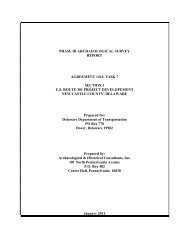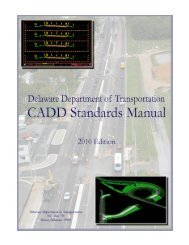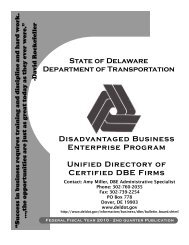Gulph Creek Stone Arch Bridge - Delaware Department of ...
Gulph Creek Stone Arch Bridge - Delaware Department of ...
Gulph Creek Stone Arch Bridge - Delaware Department of ...
Create successful ePaper yourself
Turn your PDF publications into a flip-book with our unique Google optimized e-Paper software.
Chapter 3—Historic Context for Common Historic <strong>Bridge</strong> Types<br />
3.2.8 Reinforced Concrete Tied <strong>Arch</strong><br />
History and Description: Reinforced concrete arch spans can be fixed, hinged<br />
or tied. Like tied steel arches, reinforced concrete tied arches (or through arches) are a<br />
phenomena <strong>of</strong> the twentieth century and were built to avoid heavy massive abutments,<br />
thus saving money. They were constructed during the “heroic” period <strong>of</strong> reinforced<br />
concrete arch construction, which began in the 1920s and extended till the end <strong>of</strong> the<br />
1930s.<br />
Unlike traditional fixed through arches, the ends <strong>of</strong> the ribs <strong>of</strong> the concrete tied<br />
arch are not integral parts <strong>of</strong> the piers resulting in the containment <strong>of</strong> the horizontal thrust<br />
action by the pier mass. Instead, the arch rib ends are connected to the deck by hinged<br />
shoes and rebar. The advantage <strong>of</strong> the tied arch design is that the entire structure acts as a<br />
beam and places the entire vertical load on the supporting abutments or piers, thus<br />
negating the need for large abutments to resist the thrust <strong>of</strong> the arch. Lighter, less<br />
expensive abutments could then be used. Lengths ranged from short spans <strong>of</strong> 30 to 40<br />
feet to moderately long spans in excess <strong>of</strong> 200 feet.<br />
Tied concrete arches are architecturally distinctive due to their prominent arch<br />
form. Larger spans exhibit monumental qualities, like some <strong>of</strong> Oregon state bridge<br />
engineer Conde McCullough’s coastal spans. One early example <strong>of</strong> a reinforced concrete<br />
tied-arch through bridge is the Benson Street <strong>Bridge</strong> (1910) over the gate fork <strong>of</strong> Mill<br />
<strong>Creek</strong>, about eight miles north <strong>of</strong> the Cincinnati central business district in Hamilton<br />
County, Ohio. Designed by Deputy County Surveyor E. A. Gast, this bridge may be the<br />
oldest, and first, tied arch, reinforced concrete bridge in the United States. The deck is<br />
suspended from two arch ribs by nine hangers, with the steel rods hooked around rib<br />
reinforcement above and floor rods below. The arch ribs are entirely above the travel<br />
surface. This design was chosen because studies had shown that the surviving masonry<br />
abutments from an earlier truss bridge at the site could support the load <strong>of</strong> a new bridge,<br />
if the weight <strong>of</strong> the bridge could be distributed evenly over the width <strong>of</strong> the abutments.<br />
A more modest example is State <strong>Bridge</strong> NC-246 (1942) in New Castle County,<br />
<strong>Delaware</strong>, which is that state’s first and only remaining example <strong>of</strong> this type. Like so<br />
many <strong>of</strong> the earlier tied-arch bridges that preceded it around the country, this structure<br />
replaced a metal truss bridge. Although the specific reasons for selection <strong>of</strong> a tied-arch<br />
design at this site are unknown, the type was generally employed where subsurface<br />
conditions made massive abutments or piers impractical.<br />
Significance Assessment: The concrete tied arches built before 1955 (the end <strong>of</strong><br />
the historic period covered in this study), many dating to the second quarter <strong>of</strong> the<br />
twentieth century, are notable bridge structures because <strong>of</strong> their distinctive arch form.<br />
They were not built in great numbers, thus examples that retain their character-defining<br />
features will possess significance within the context <strong>of</strong> this study. Character-defining<br />
features include the curved top chord (rib), bottom chord, suspenders/ties/hangers, hinged<br />
shoes, floor beams, and wingwalls, abutments or piers. Railings may also be characterdefining<br />
features <strong>of</strong> some bridges.<br />
3-71






